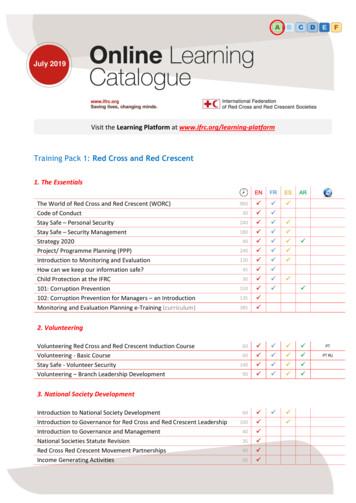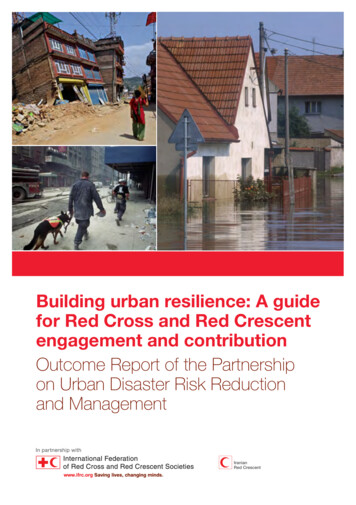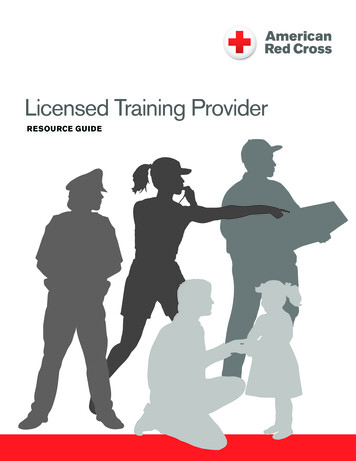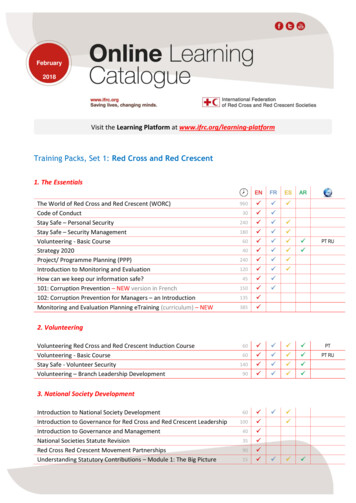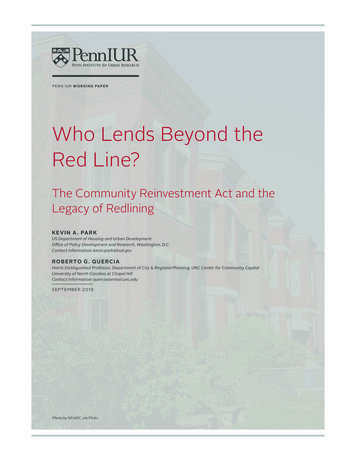
Transcription
P E N N I U R WO R K I N G PA P E RWho Lends Beyond theRed Line?The Community Reinvestment Act and theLegacy of RedliningK E V I N A . PA R KUS Department of Housing and Urban DevelopmentOffice of Policy Development and Research, Washington, D.C.Contact Information: kevin.park@hud.govR O B E R TO G . Q U E R C I AHarris Distinguished Professor, Department of City & Regional Planning; UNC Center for Community CapitalUniversity of North Carolina at Chapel HillContact Information: quercia@email.unc.eduS E P T E M B E R 2 019Photo by NCinDC, via Flickr.
2 Penn IUR Working Paper Who Lends Beyond the Red Line? The Community Reinvestment Act and the Legacy of RedliningContentsThe opinionsexpressed arethose of theauthors, and do notnecessarily reflectthe policies of theUS Department ofHousing and UrbanDevelopment orthe Administration.This work wasauthored as partof the contributor’sofficial duties asan Employee ofthe United StatesGovernment and istherefore a work ofthe United StatesGovernment. Inaccordance with17 U.S.C. 105, nocopyright protectionis available for suchworks under U.S. Law.Introduction.3Historical Neighborhood Risk Rating.3Fair Housing and Community Reinvestment Law.5Effectiveness of the Community Reinvestment Act.7Methodology. 8Findings.9Past Redlining and Current Economic Conditions.9CRA Lending in Historically Redlined A B S T R AC T“Redlining” is when financial institutions refuse to serve to particular neighborhoods, often based on theirracial and ethnic composition. Maps like those infamously created by the New Deal’s Home Owners’ LoanCorporation in the Great Depression rated and color-coded neighborhoods, assigning red to those consideredthe greatest credit risk. The Community Reinvestment Act was passed in 1977 to combat the legacy andpractice of redlining. However, we find neighborhoods rated “declining” or “hazardous” in the 1930s are stillassociated with worse economic conditions eight decades later. Moreover, while we find evidence that CRAencourages local banks and thrifts to lend to lower-income borrowers, we find no difference in the marketshare of CRA-regulated lenders in lower-income neighborhoods. In fact, these institutions lag the market inhistorically redlined neighborhoods.Keywords: housing finance, mortgage, redlining, Home Owners’ Loan Corporation, Community ReinvestmentActA B O U T T H E AU T H O RSKevin A. Park is an economist in the Housing Finance Analysis Division of the US Department of Housing andUrban Development. His work focuses on housing finance, particularly homeownership and mortgage insuranceoffered through the Federal Housing Administration. He earned his doctorate in City and Regional Planningfrom the University of North Carolina at Chapel Hill. He previously worked in the UNC Center for CommunityCapital and Harvard University’s Joint Center for Housing Studies.Roberto G. Quercia is Trudier Harris Distinguished Professor of City and Regional Planning and the Director ofthe UNC Center for Community Capital at the University of North Carolina at Chapel Hill. His work focuses onthe economics and financing of affordable housing. He has published books and numerous articles and reports,primarily on the topics of low-income homeownership, affordable lending. He teaches courses on housingeconomics, real estate development, and personal finance.
Penn IUR Working Paper Who Lends Beyond the Red Line? The Community Reinvestment Act and the Legacy of Redlining 3I N T RO D U C T I O NRedlining refers to the practice of discrimination, particularly in financial and insurance markets, based onlocation. In the United States, redlining is often associated with historical maps created by federal agencieslike the Federal Housing Administration (FHA) and Home Owners’ Loan Corporation (HOLC) during the GreatDepression (Jackson 1980). Civil rights legislation in the mid-twentieth century outlawed the use of raceand other protected classes, including proxies such as neighborhood, in housing and credit markets. Theseefforts culminated in the Community Reinvestment Act of 1977 (CRA) which went beyond restrictions againstcertain practices to create an affirmative obligation for financial institutions to meet the credit needs of theircommunities in a safe and sound manner. In today’s mortgage market, CRA has played a limited but effectiverole in expanding access to credit for lower-income borrowers and neighborhoods.CRA encourages banks and thrifts to lend to lower-income borrowers and neighborhoods in regions wherethey have a local branch office. But the mortgage market has changed significantly since 1977. Non-depositorymortgage companies now originate most home loans, not CRA-regulated banks. And even CRA-regulatedinstitutions often lend outside their local markets. These limitations often provide natural experiments forstudies on the effectiveness of CRA.Despite the documented effects of fair housing and community reinvestment policies, recent research has alsoshown persistent geographical differences in economic opportunity (Chetty et al. 2018). With the digitization ofHOLC security maps from the 1930s, some of these disparities have been connected to historical federal policy(Mitchell and Franco 2018; Krimmel 2018; Aaronson et al. 2019). But the connection of redlining in the past toCRA today has not been examined. In this paper we provide a brief history of redlining and subsequent effortsto undo its legacy. We provide empirical evidence that neighborhood risk ratings in the past are associatedwith differences in socioeconomic conditions in the present. Then we examine whether, given the affirmativeobligation to meet the credit needs of their communities, CRA-regulated lenders lead the market in lending tohistorically redlined neighborhoods.H I S TO R I C A L N E I G H B O R H O O D R I S K R AT I N GThe Home Owners’ Loan Corporation Act of 1933 (Pub. L. 73-43, June 13, 1933) created a new agency in theFederal Home Loan Bank Board (FHLBB) (itself created a year earlier) to purchase and refinance delinquenthome mortgages into self-amortizing loans with longer terms and higher loan-to-value ratios than commonlyavailable at the time. At its peak in 1935, HOLC held nearly 19 percent of all mortgage debt on one- to fourfamily homes in the country (Wheelock 2008).Harris’s (1951) History and Policies of the Home Owners’ Loan Corporation states the HOLC received 1,886,491applications, representing an estimated 40 percent of all mortgagors in the country, but 46 percent wererejected or withdrawn. Courtemanche and Snowden (2010) find applications and acceptance rates were higherin counties with higher pre-crisis home values, likely because of more extensive use of mortgage financing, andgreatest economic distress. Acceptance rates were also higher in counties closer to HOLC offices, providing aninstrument to estimate the impact of HOLC activity; however, the location of HOLC offices was not random.After accounting for the endogeneity of the distribution in HOLC activities, Courtemanche and Snowden (2010)and Fishback et al. (2010) find minimal impact on the overall housing market. Yet both find a significant increasein house values in smaller counties. Fishback et al. (2010) argue smaller counties may have had more localizedmortgage markets and financial institutions that were in greater need of federal assistance.Under the terms of the legislation, eligibility was limited to distressed mortgages secured by non-farm one- tofour-family properties appraised for less than or equal to 20,000. In addition, mortgages were limited to thelesser of 80 percent of the appraised value or 14,000. Principal reductions became available for LTV ratios
4 Penn IUR Working Paper Who Lends Beyond the Red Line? The Community Reinvestment Act and the Legacy of Redlininggreater than 80 percent. Consequently, the appraised value was an integral component of determining HOLCaction. HOLC policy estimated the “fair worth” of a property based on the average three values, of whichmarket value was only one. The other components included the cost of construction net of depreciation on acomparable lot and the capitalization of estimated historical rent. In a declining market, the latter techniqueroutinely yields an estimate above the current market value. In a sample of HOLC cases from Connecticut, NewJersey and New York, Rose (2011) finds the final appraised value exceeded HOLC’s own estimate of the marketvalue in over 58 percent of properties, with a 4 percent average markup. Rose argues the liberal appraisalpolicy was a deviation from congressional intent by state officials designed to increase lender participation andrecapitalize financial institutions.In addition to property and borrower evaluation, new federal underwriting guidelines also evaluated thelocation of the property. HOLC and FHLBB created the City Survey Program to produce detailed maps of 239cities. “Best” or “A” neighborhoods were colored green and “Still Desirable” or “B” neighborhoods blue, while“Definitely Declining” “D” neighborhood were yellow and “Hazardous” “D” neighborhoods were, of course, red.Although Harris (1951) does not specifically mention neighborhood risk ratings, he notes, “Instructions remindedthe appraisers that, in general, cities had stopped growing, indicating the need for caution in estimating‘higher potential use and value’” (46). In addition, contemporaneous FHA underwriting manuals prescribedneighborhood risk rating, including economic stability and protection from adverse influences. “It is not thepolicy of the Federal Housing Administration to exclude entire cities and towns from the benefits of mutualmortgage insurance. It may well be, however, that within certain communities whose present-day and expectedfuture stability is exceedingly low, only certain favored locations which surpass the general average of the townor community may prove acceptable for insurance. The rating ascribed shall apply to all locations situated inthe area rated” (FHA 1936, Part II-216). Protection against adverse influences was “one of the most importantfeatures in the Rating of Location Where little or no protection is provided against adverse influences theValuator must not hesitate to make a reject rating of this feature” (FHA 1936, Part II-226). Zoning and deedrestrictions were encouraged. “Usually the protection against adverse influences afforded by these meansinclude prevention of the infiltration of business and industrial uses, lower-class occupancy, and inharmoniousracial groups” (FHA 1936, Part II-229). Hillier (2005) uses spatial regression to analyze the determinants ofHOLC grades and finds that “even when controlling for the value and condition of housing, race and immigrantstatus influenced the neighborhood appraisals” (227).It is not clear how influential the HOLC security maps were at the time. Despite a policy and practice ofgenerous property valuations, over 21 percent of rejected HOLC applications were denied for “inadequatesecurity” (Harris 1951). However, Hillier (2003a) argues that the HOLC maps were developed after HOLC wasmost active and were not widely distributed. Hillier examines the HOLC map of Philadelphia and a randomsample of property transactions between 1938 and 1950 and finds a statistically significant relationshipbetween lower neighborhood rating and higher mortgage interest rates, but no consistent relationship with thenumber of mortgages. In fact, Hillier (2003b) finds HOLC lending was disproportionately to Black, Jewish, andforeign-born residents compared to their share of homeowners and disproportionately to older, lower-valued,“Colored” and “Hazardous” (“D”-rated) neighborhoods.1Yet others find a persistent legacy of HOLC neighborhood risk rating on economic outcomes today. Usingdecades of census data, Krimmel (2018) and Aaronson et al. (2019) compare conditions in borderingneighborhoods with different risk ratings. Krimmel finds “D” rated neighborhoods experienced disproportionatedeclines in the number of housing units and population density over the course of the 20th century relativeto “C” neighborhoods. Similarly, Aaronson et al. find lower graded neighborhoods experienced relativeincreases in the Black share of the population as well as decreases in homeownership, credit scores, housevalues and rents. The difference between “B” and “C” graded neighborhoods is particularly large. However,the gap narrows after 1970, which the authors attribute to the implementation of fair housing and community
Penn IUR Working Paper Who Lends Beyond the Red Line? The Community Reinvestment Act and the Legacy of Redlining 5reinvestment legislation. 2 Nevertheless, Mitchell and Franco (2018) report that nearly three out of four“Hazardous” neighborhoods are Low- or Moderate-Income (LMI) (median family income less than 80 percent ofarea median) today compared to less than 9 percent of “A” rated neighborhoods, and 64 percent are currentlymajority-minority compared to 14 percent, respectively.FA I R H O U S I N G A N D CO M M U N I T Y R E I N V E S T M E N T L AWDiscrimination in housing was ostensibly prohibited by the Civil Rights Act of 1866 (14 Stat. 27–30), whichstates that citizens “of every race and color, without regard to any previous condition of slavery or involuntaryservitude shall have the same right, in every State and Territory in the United States, to make their rightsand enforce contracts, to sue, be parties, and give evidence, to inherit, purchase, lease, sell, hold, and conveyreal and personal property ” Further, the Supreme Court ruled in 1917, “A city ordinance forbidding coloredpersons from occupying houses as residences, or places of abode or public assembly, on blocks where themajority of the houses are occupied by white persons for those purposes, and in like manner forbidding whitepersons when the conditions as to occupancy are reversed, and which bases the interdiction upon color. andnothing more, passes the legitimate bounds of police power, and invades the civil right to acquire, enjoy and useproperty, which is guaranteed in equal measure to all citizens, white or colored, by the Fourteenth Amendment”(Buchanan v. Warley, 245 U.S. 60 (1917)). And review of national bank charter applications considered “theneeds of the community to be served” since at least 1918.3 Yet de jure discrimination and segregation persistedthrough Reconstruction for another hundred years. In fact, the federal government was instrumental inspreading institutionalized discrimination even to areas where it had not previously rooted (Coates 2014;Rothstein 2017).Fair housing advocacy gained momentum in the mid-twentieth century. As early as 1946, the United Statesbrought an anti-trust case against 39 banks and other financial companies in New York, claiming that thedefendants had created maps of where Black and Hispanic people lived and refused to originate mortgages inthose areas, depriving residents the benefits of competition. A consent decree enjoined the defendants fromcontinuing the alleged practices (63 Yale L.J. 1124 (1954)). Two years later, the Supreme Court ruled raciallyrestrictive covenants unenforceable under the Equal Protection Clause of the Fourteenth Amendment (Shelly v.Kraemer 334 U.S. 1 (1948)).In 1962, President Kennedy issued Executive Order 11063 directing federal agencies “to take all actionnecessary and appropriate to prevent discrimination because of race, color, creed, or national origin in thelending practices with respect to residential property and related facilities (including land to be developed forresidential use) of lending institutions, insofar as such practices relate to loans hereafter insured or guaranteedby the Federal Government” (27 FR 11527). Within three decades of codifying racial segregation in mortgageunderwriting, agencies like FHA and FHLBB had reversed course and have since become a vital source ofmortgage credit in underserved communities.However, Kennedy’s directive only applied to federal agencies. Redlining continued to be permitted by privatelenders in an era of marked racial segregation and distress in urban neighborhoods. Following the race riotsof the “long, hot summer” of 1967, the National Advisory Commission on Civil Disorders, better known as theKerner Commission, investigated its causes. “The first is surely the continuing exclusion of great numbers ofNegroes from the benefits of economic progress through discrimination in employment and education andtheir enforced confinement in segregated housing and schools. The corrosive and degrading effects of thiscondition and the attitudes that underlie it are the source of the deepest bitterness and lie at the center ofthe problem of racial disorder” (91). The report summarizes its conclusion, “Our Nation is moving toward twosocieties, one black, one white—separate and unequal” (1).
6 Penn IUR Working Paper Who Lends Beyond the Red Line? The Community Reinvestment Act and the Legacy of RedliningAfter the assassination of Dr. Martin Luther King, Jr., Congress passed the Civil Rights Act of 1968 (Pub. L. 90284, April 11, 1968). Title VIII, known as the Fair Housing Act, states, “ it shall be unlawful for any bank, buildingand loan association, insurance company or other corporation, association, firm or enterprise whose businessconsists in whole or in part in the making of commercial real estate loans, to deny a loan or other financialassistance to a person applying therefor for the purpose of purchasing, constructing, improving, repairing, ormaintaining a dwelling, or to discriminate against him in the fixing of the amount, interest rate duration, or otherterms or conditions of such loan or other financial assistance, because of the race, color, religion, or nationalorigin of such person ” Federal courts ruled this section of the Act, “as an explicit prohibition of ‘redlining’”(Laufman v. Oakley Bldg. & Loan Co., 408 F. Supp. 489 (S.D. Ohio 1976)).In the Equal Credit Opportunity Act of 1974 (Pub. L. 93-495, October 28, 1974, Title V), Congress found, “thereis a need to insure (sic) that the various financial institutions and other firms engaged in the extensions of creditexercise their responsibility to make credit available with fairness, impartiality, and without discrimination onthe basis of sex or marital status.” And made it “unlawful for any creditor to discriminate against any applicanton the basis of sex or marital status with respect to any aspect of a credit transaction.” Amendments in 1976extended protection to race, color, religion, national origin, age and public assistance (Pub. L. 94-239, March 23,1976).However, these laws were intrinsically limited by the focus on restrictions against discrimination enforcedby federal bureaucrats. Applicants must be aware of being the victim of a specific act of disparate treatmentand find a willing regulator, who are typically more focused on bank safety and soundness. Moreover, fairhousing and equal opportunity legislation does not address the collective action dilemma of reinvestmentin underserved neighborhoods. Profit-maximizing financial institutions may find themselves in a “Prisoners’Dilemma” when it comes to being the first mover into a neighborhood that lacks information on collateralvalues and borrower performance. After one pioneering bank builds the market, accessing this risk informationwould be easier for other banks (Davis and Whinston 1961; Lang and Nakamura 1993; Ling and Wachter 1998;Bernanke 2007; Haltom 2010).Two additional pieces of legislation provided a fundamentally different approach to community reinvestment.In 1975, Congress determined “some depository institutions have sometimes contributed to the decline ofcertain geographic areas by their failure pursuant to their chartering responsibilities to provide adequatehome financing to qualified applicants on reasonable terms and conditions.” In response, Congress passedthe Home Mortgage Disclosure Act (HMDA) (Pub. L. 94-200, December 31, 1975) “to provide the citizens andpublic officials of the United States with sufficient information to enable them to determine whether depositoryinstitutions are filling their obligations to serve the housing needs of the communities and neighborhoods inwhich they are located and to assist public officials in their determination of the distribution of public sectorinvestments in a manner designed to improve the private investment environment” (Pub. L. 94-200, Dec.31, 1975, Title III). Banks would be required to publicly release information on the number and amount ofmortgages originated by census tract.The information provided under HMDA enabled “regulation from below,” as researchers and communityadvocates acted as unofficial bank examiners (Fishbein 1992). For example, Bill Dedman received the PulitzerPrize in 1989 for “The Color of Money,” a series of articles in The Atlanta Journal-Constitution documentingracial disparities in mortgage lending, beginning with the lede, “Whites receive five times as many home loansfrom Atlanta’s banks and savings and loans as blacks of the same income” (Dedman 1988). Over time, HMDAcoverage has been expanded to include non-depository lenders and application-level reporting of importantloan, property and applicant characteristics.Then in 1977 Congress passed the Community Reinvestment Act (CRA) (Pub. L. 95-128, Oct. 12, 1977), whichreiterated the requirement that banks “serve the convenience and needs of the communities in which they
Penn IUR Working Paper Who Lends Beyond the Red Line? The Community Reinvestment Act and the Legacy of Redlining 7are chartered to do business,” but went further to state, “regulated financial institutions have continuing andaffirmative obligation to help meet the credit needs of the local communities in which they are chartered.” Bankregulators would “assess the institution’s record of meeting the credit needs of its entire community, includingLMI neighborhoods, consistent with safe and sound operation of such institutions.” Senator Proxmire, whointroduced the legislation, stated,The bill is based on two widely shared assumptions.No. 1: Government through tax revenues and public debt cannot and should not provide more than a limitedpart of the capital required for local housing and economic development needs. Financial institutions in ourfree economic system must play the leading role.Second: A public charter for a bank or savings institution conveys numerous benefits and it is fair for thepublic to ask something in return. 4The “affirmative obligation” under CRA helps overcome the collective action dilemma of investment inunderserved neighborhoods and counter the legacy of redlining. Notably, however, CRA regulations donot explicitly incorporate race and ethnicity into the definition of community or the obligation of financialinstitutions despite being a primary basis for neighborhood discrimination.5CRA has been controversial since its introduction. Armed with HMDA data, advocates contend banks arecontinuing de facto redlining and neglecting profitable lending opportunities. Others insist HMDA omits keyunderwriting factors and decry government intervention in financial markets. Research over the last twodecades has found that CRA is effective in encouraging banks to lender to lower income households but limitedin its impact on the overall mortgage market.E F F E C T I V E N E S S O F T H E CO M M U N I T Y R E I N V E S T M E N T AC TCRA’s critics argue that the affirmative obligation to serve lower-income communities led to a deteriorationin mortgage underwriting standards that fueled the financial crisis in the 2000s (Pinto 2008; Wallison 2011;Agarwal et al. 2012). However, developments in the mortgage market over the last several decades havereduced the share of the market subject to CRA (Avery, Courchane and Zorn 2009). CRA covered only afraction of lending during the peak of the housing market (Park 2008; 2010). Berry and Lee (2008) find nodirect impact of CRA on lending and Dahl, Evanoff and Spivey (2002) find that lending in LMI areas did notincrease after lending institutions received a “poor” CRA rating.Further, an abundance of research finds CRA-related mortgages performed at least as well as other loansduring the subsequent recession (Laderman and Reid 2009; Ding et al. 2011; Ghent, Hernandez-Murilloand Owyang 2015; Avery and Brevoort 2015; Bhutta and Ringo 2015). Similarly, Reid et al. (2013) providesan extensive rebuttal to Agarwal et al. (2012) and others to conclude “no credible research to support theassertion that CRA contributed to an increase in risky lending during the subprime boom.”More recent studies do find and association between CRA regulation and lending, often exploiting naturalexperiments in CRA eligibility (Bhutta 2011). Ding and Nakamura (2017) find that when census tracts inPhiladelphia lose CRA eligibility because they are no longer considered LMI, lending in those tracts experienceda decrease in lending of 10 to 29 percent. Ringo (2017) finds that when a census tract gained CRA eligibility,lending increases by two to four percent. Butcher and Munoz (2017) use a regression discontinuity and findCRA eligibility is associate with a reduction in the “thin file” and “credit invisible” share of the population, anda 9 percent increase in the number of loans but not significant increase in delinquency. These findings areconsistent with an earlier study by Gabriel and Rosenthal (2009) where they find that CRA mortgage lendingresults in small increases in the homeownership rate in CRA assessment areas. Casey, Farhat, and Cartwright
8 Penn IUR Working Paper Who Lends Beyond the Red Line? The Community Reinvestment Act and the Legacy of Redlining(2017) find that lending significantly increases when banks and community groups negotiate agreements thatcommit banks to specific increases in lending. Van Tol (2019) estimates that since 1996, banks complying withCRA have made more than 1 trillion in community development lending and issued another 1 trillion in smallbusiness lending in CRA eligible census tracts.Other studies have examined the impacts of CRA on small business lending and financial services. Ding, Leeand Bostic (2018) examine changes in area CRA eligibility on small business lending. As the studies mentionedabove, the authors find that loss of CRA eligibility is accompanied by a decline in lending, while gaining CRAeligibility is accompanied by an increase in lending. Using a different methodology, Bostic and Lee (2017) findthat small business lending increases more in moderate income CRA eligible tracts than in census tracts thathave incomes slightly above the CRA limit (higher than 80 percent of area median income). Stegman, Cochranand Faris (2002) find evidence of rating inflation in CRA evaluations of financial services.Taken together, the evidence indicates that the CRA promotes more lending in LMI communities, but onlyincrementally. Further, the narrow focus on exploiting natural experiments to find exogenous variation in CRAeligibility to estimate local area treatment effects, while necessary for establishing causality, may also miss thebroader issue of geographic disparities along dimensions other than income. In particular, the question remainswhether CRA helps ameliorate the legacy of redlining, which was often associated with race and ethnicityrather than income.M E T H O D O LO GYAlthough HOLC’s City Survey Program may not have directly caused redlining, they are still a reflection of theattitudes of financial institutions at the time of the credit risks associated with certain neighborhoods anda primary historical source for where redlining was likely occurring or would occur. Geo-rectified shapefilesof HOLC graded areas for certain cities are available from the Digital Scholarship Lab at the University ofRichmond (Nelson et al. 2019). Given Co
they have a local branch office. But the mortgage market has changed significantly since 1977. Non-depository mortgage companies now originate most home loans, not CRA-regulated banks. And even CRA-regulated institutions often lend outside their local markets. These limitations often provide natural experiments for studies on the effectiveness .




